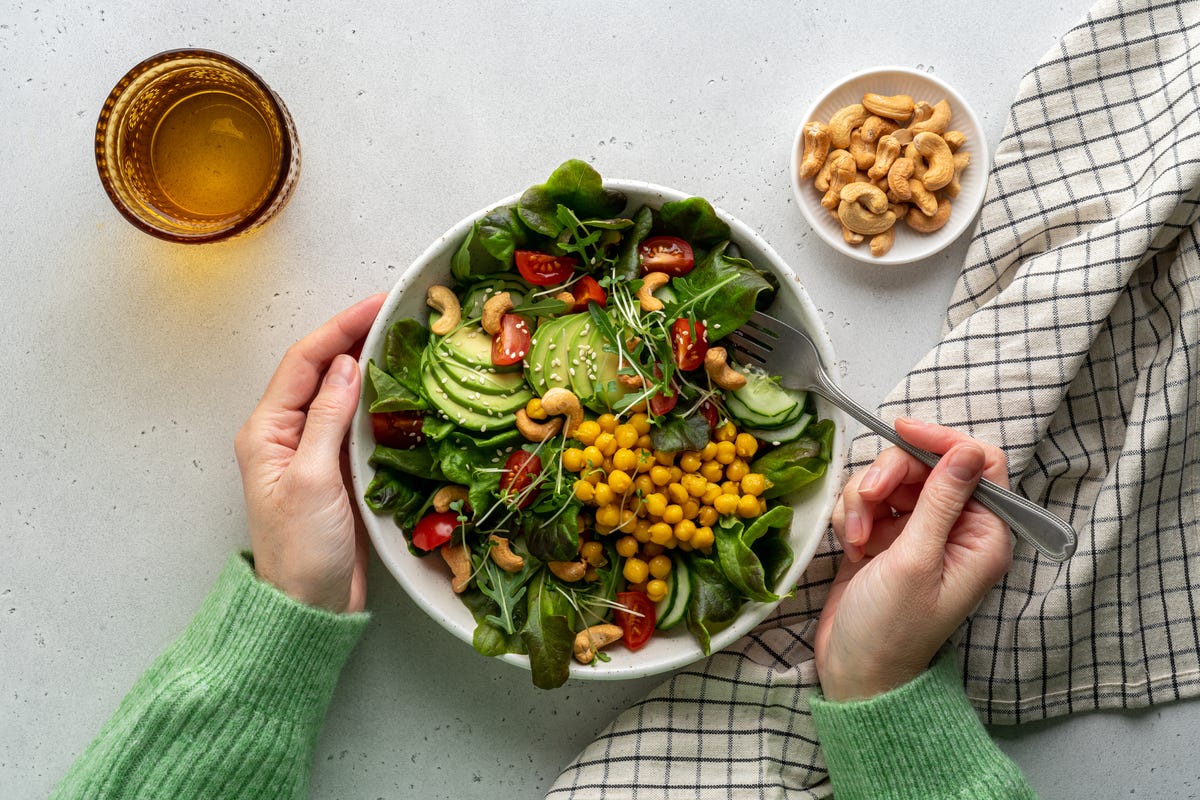[ad_1]
Many of you are all too familiar with this routine: You get home late from work hungry and tired, and you whip up a quick dinner and scarf it down before you’ve even had time to pick out which Netflix show you were going to watch while eating. Even though this practice is relatable, believe it or not it’s not the healthiest for your nutrition.
It’s important to eat mindfully: The practice of staying present while eating, feeling all the sensations of the food and noticing when you begin to feel full. While mindful eating may ring a bell from its growing popularity within the wellness industry and on social media, it’s actually an ancient practice that can overall make us feel better about our eating habits.
I spoke to two experts, Kristen Bunich, a registered dietitian nutritionist and owner of The Intuitive Dietitian based in Charlotte, North Carolina, and David Gaviria, a doctorate student at UNC-Chapel Hill’s Department of Nutrition, to learn more about the art of remaining present while eating and how you can practice mindful eating each and every day.
What is mindful eating?
Mindful eating makes use of many of the main tenets of mindfulness, including staying fully present and thinking deeply about our behaviors and feelings. Mindfulness is a concept based on Zen Buddhism and first defined by Jon Kabat-Zinn, a professor and leader of the Mindfulness-Based Stress Reduction program at the University of Massachusetts Medical School. Mindfulness is about learning to handle the stresses of life and improving your mental and physical health.
Bunich said mindful eating is specifically the act of developing an awareness to the experience of eating. It involves becoming aware of your senses and feelings around the meal, as well as physical sensations and how your body responds — all without judgment. It’s a way of changing one’s eating behaviors and relationship with food.
Mindful eating is more than just eating when hungry and not eating when full. And the sensory experience goes beyond just thinking about taste. Mindful eating can include how the food looks on the plate, how it smells, the texture, the crunch or softness, and how all of that makes you feel during the eating process.
Read also: What Is Body Neutrality and How Can I Start to Practice It?

To minimize distractions while eating, put away your phone, turn off the TV and don’t play music.
Kilito Chan/Getty Images
What are the benefits of mindful eating?
Distracted eating is now the norm. It’s common for people to eat lunch at their desks, eat snacks while scrolling social media, or finish dinner while watching TV. Bunich points out that we live in a world where many take pride in being busy and multitasking, but when we lose focus on our eating, we can lose satisfaction with food and lose the hunger-fullness connection.
“There are many benefits to being a more mindful eater,” Bunich said. “Slowing down the pace of eating will ease digestion and bloating. The slower pace also helps in reconnecting with fullness cues. If you were previously overeating, this may aid in preventing weight gain or even some weight loss. But the greatest benefit may be a newfound satisfaction for food and increased enjoyment of your meals.”
Gaviria said that mindful eating is a great practice he recommends to many people, as long as people are careful not to add in aspects of diet culture. It’s a way to deeply appreciate food and how your body reacts to it, rather than being a weight loss method.

Mindful eating is a way to deeply appreciate food and how your body reacts to it, rather than being a weight loss method.
vorDa/Getty Images
How can you practice mindful eating?
It’s easy to get busy and deprioritize mealtimes, but there are steps you can take to refocus your relationship with food. Bunich explained that mindful eating starts before you prepare your plate. Before you start eating, pause to think “Why am I eating? Am I hungry, bored, stressed or emotional at the moment?” and go from there.
Gaviria walked me through what he does with his clients to practice eating more mindfully.
“I tell them to get into a place that’s distraction-free, so put away their phone, turn off the TV, turn off the radio, and just start to sit there,” Gaviria said. “Close your eyes, be present and notice how you’re feeling. Then, get whatever piece of food that you want to try mindful eating with.” (This method originally started with raisins, but it can be used on any food.)
The first thing you should do is look at the food on the table and really take in how it looks. Think about the colors, if it has any textures. Is it straight, curved, bent? After spending time thinking about the food, then you pick it up. Notice if it’s rough, smooth, sticky, greasy or something else. After you’ve done that, you might even start to gently squeeze the food with your hands. Then, smell it. Hold it up to your nose and take time to define all of the different notes that hit your nose with each breath.
Finally, take a bite of it and begin to ask yourself questions to really observe the food’s flavor: Does it taste different after doing these exercises? Do you enjoy the taste or not enjoy the taste? How does it feel in your mouth? Is it a texture that you like? Does it spread out in your mouth or stick in a certain area? What does it taste like initially and how does it change over time? Are there any noises you notice as you chew? And how did that make you feel?
This routine touches on each sensory aspect of eating, making it a great way to start eating more mindfully. Gaviria said people are likely not going to use this routine everyday, every meal or with every bite of food, but this is a good place to start when doing a deeper introduction.

One good way to be more mindful while eating is to take designated lunch breaks rather than working from your desk.
sturti/Getty Images
More examples of mindful eating
Experts break down some effective steps to be more mindful that you can use with any meal:
- Create a detailed grocery list before going to the store.
- Don’t watch TV or be on social media as you eat.
- Don’t eat at your desk while working.
- Set aside certain periods during the day only to cook and eat.
- Sit at a table rather than eating on the couch or eating while standing up.
- Start with a manageable portion on your plate and add more as needed.
- Eat when you feel hungry, but don’t wait to eat until ravenous (and don’t skip meals).
- Eat slowly and make note of the different flavors you taste in each bite.
- Use all your senses, considering the color, smell, taste and texture of the food.
- Take smaller bites.
- Chew each bite completely before swallowing (experts recommend chewing 20 to 40 times per bite).

To practice mindful eating, take notice of the different colors, textures, smells and flavors of your meal.
Natalia Gdovskaia/Getty Images
How is mindful eating different from intuitive eating?
While some might use these terms interchangeably, there are some key differences between mindful eating and intuitive eating. “Mindfulness really goes down to sensory experience with the food,” Gaviria said, “while intuitive eating includes a broader scope of [the] framework of eating, where you notice your hunger cues before going into a meal. You’re taking into account the factors of your day related to how much you’re going to eat and so on.” He added, “Intuitive eating also talks about body respect and noticing how you feel in your body and appreciating it, regardless of how it looks.”
Gaviria emphasizes that context really matters with intuitive eating. An example would be a situation in which a mom eats a light dinner before her child’s football game, even if she’s not really hungry at that moment. She knows she will be away from home and unable to eat for several hours, so this will prevent overeating later on. It could also include an athlete eating before or after a workout to fuel their physical activity or to recover. It surpasses just the sensory element of mindfulness, and takes into account your whole day and how that impacts eating habits.
The bottom line
Centering yourself is always important to cut through the chaos of everyday life, and mindful eating can help. Being distracted during mealtimes can cause both over- and undereating, so it’s crucial to pay attention and make sure we’re fueling our bodies in a way that makes us feel good.
Mindful eating isn’t about losing weight or eating less, it’s about refocusing our experience with food, or as Bunich said: “It’s a great tool in the tool box for connecting and healing a relationship with food.”
More for your nutrition
The information contained in this article is for educational and informational purposes only and is not intended as health or medical advice. Always consult a physician or other qualified health provider regarding any questions you may have about a medical condition or health objectives.
[ad_2]
